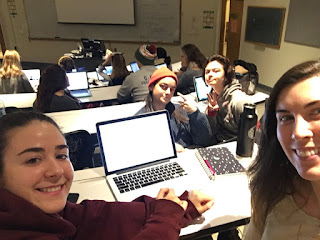- I’ve been doing some research on NOFA,
looking at all your different programs and events the organization holds. NFOA
covers such a broad range of topics within the Vermont farming and organic food
community that I almost became overwhelmed with the amount that your
organization covers, could you explain in more simple terms what NOFA does and
how you operate?
NOFA works on 3 main
activities:
1) To increase the demand for organic food (through our work
on marketing, farm to school, certification and food access)
2) To
increase the supply of organic food (through our Beginning Farmer programs and
technical assistance)
3) To educate and advocate for local, organic food
(through our workshops, conferences and policy work).
- You have been with NOFA since 1987, what are
the biggest changes you seen within the organization and where would like to
see NOFA go in the next decade or so? What are your broader goals for the
organization in the years to come?
The biggest changes I
have seen are the shift in consumer perception of organic from something that
is full of bugs and grown by hippies (the 80’s) - to elitist and inaccessible
(90’s) - to the best thing since sliced bread (early 2000’s) - to usurped by
“local”. People care more about the source of the food than they did when
I started this work but they equate “local” with “healthy”.
Some significant goals
moving forward include:
- Increasing the
engagement of our membership. I want everyone to feel as if they are part
of this movement, not just farmers, and that their voice and actions matter.
Most consumers are complacent - and we want individuals to become much
more engaged in the future of our food supply. Ideally, more people will
want to become members because we are change makers - and they will join us in
that pursuit.
- Increasing the
viability of organic farmers. We are working on this now through cost of
production research, production efficiencies, business planning etc… No
farms = No food. We need farms that are financially viable - partly this
is due to farmers needing to be much better business managers, but this is also
due to consumers needing to pay the true cost of food.
- As an Executive Director,
one of my goals for the organization also has to do with a highly functioning board
of directors. The board is in transition, and I see that an important
focus of my work in the next several years is to strengthen the board.
- We met with Kim recently and she had
mentioned to us that membership has been at a bit of a stand still for about 10
years now, in your opinion why do you think that is?
I think it has to do
with the fact that consumers are generally satisfied with “local”, and that
they equate local with healthy, as indicated above. For most of NOFA’s
existence (since 1971), we were the only show in town for individuals who cared
about healthy farms and food - we were instrumental in organizing farmers
markets, supporting CSAs and providing education about an “alternative” food
system to conventional ag. Now the food scene is so much more muddled
with organic food in Walmart, Costco, and major supermarkets. It is not
an underdog movement anymore. People don’t “join” because they don’t need
to - it is everywhere they look. And perhaps, we have not taken credit
for the success of this food movement transition and we need to ask them to
stand with us.
- What are the benefits of being a member of
NOFA for farmers and more specifically non-farmers?
The biggest benefit of
membership for farmers are discounts on educational events, access to farmer
mentorship, bulk order discount on organic farming supplies, access to
low-interest loans and grants, and a lot of opportunity for peer to peer
learning. Certified organic farmers gain access to markets and increased value
of their product due to the Vermont Organic Farmers brand. Non-farmers
have discounts on educational events as well, along with discounts on gardening
supplies (the bulk order), and limited income Vermonters gain access to direct
markets through our food security programs (e.g. Farm Share, EBT at Farmers
Markets). All consumers (including farmers) benefit from all of the
market development we have done - farm to school, farm to institution, farm
stand, farmers markets, CSAs. Additionally, we hear that people want to
be part of a healthy food movement. NOFA gives people hope and something
to believe in. So, whereas that is not a financial asset to membership,
it is a significant non-economic benefit.
- As public communications students my group
members and I have many ideas regarding telling NOFA’s story and ideally
increasing membership of both farmers and non-farmers. Is there a specific type
of communications strategy you believes works best for NOFA or one that you
would like us to use to increase you membership?
I think short
testimonials are powerful - photos of a person(s) our work has impacted and a
quote. I think longer stories (for CSA member newsletters and food coop
newsletters) about our work would also be valuable - those are target audiences
for us to build our membership and I think a lot of people don’t know the scope
of our work.
- How do you feel about using different forms
of social media (i.e. Facebook, Instagram, blogging, etc.) to communicate with
a wider audience? Do you think one would be more successful than the others and
why?
I think instagram and
short videos embedded in Instagram are important for reaching millennials, as
is FB and blogs. But I also think that op eds in newspapers or a regular
column in print or radio would be great outreach for a different (older)
audience.


